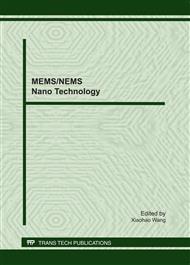p.341
p.345
p.350
p.354
p.359
p.364
p.370
p.374
p.381
Rapid Microfluidc Biochips Fabrication by Femtosecond Laser on Glass Substrate
Abstract:
This paper uses a femtosecond laser scriber to perform the direct-writing ablation of glass substrate for the development of microfluidic biochips. The surface quality of the ablated microchannels was examined by scanning electron microscopy (SEM) and atomic force microscopy (AFM) measurement techniques. The developed femtosecond laser ablation system provides a versatile and economic approach for the fabrication of glass-base microfluidic chips. In the laser writing process, the desired microfluidic patterns are designed using commercial computer software and are then transferred to the laser scriber to ablate the trenches. The results show that a very smooth channel wall can be achieved through the annealing process at the temperature 650°C and 5 hours. The system provides an economic and powerful means of rapid glass microfluidic biochips development.
Info:
Periodical:
Pages:
359-363
Citation:
Online since:
June 2011
Keywords:
Price:
Сopyright:
© 2011 Trans Tech Publications Ltd. All Rights Reserved
Share:
Citation:


